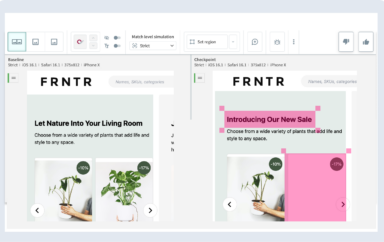Gartner recently published a report that said: “application leaders should embrace AI-augmented development now, or risk falling further behind digital leaders.”* In today’s visual economy, customers are increasingly interacting with companies through a screen. For this reason, digital transformations are all about delivering quality at high velocity along with stability. To do this, leading firms of all sizes and verticals are embracing AI as a critical layer in their tech stack.
Why does AI matter to Digital Transformation?
Because it can help automate the error-prone and mundane tasks that often pull humans away from higher value tasks for an organization. The Gartner report states, “while early AI-augmented development addresses mundane, ‘plumbing’ tasks, this is exactly where application leaders can benefit from further automation and cost reduction.”*
However, we know that simply using AI for its own sake won’t get you very far. While these types of technological advancements can certainly help increase your productivity and increase the velocity of your software development pipeline, the areas where you can get the most proverbial “bang for your buck” is in processes that are either 1) entirely manual or 2) extremely frequent tasks (or sometimes both).
According to Gartner, “today’s statistical techniques are inadequate for optimizing testing, especially when changes to applications are frequent and where large software assets already exist that use a wide variety of microservices. Development and quality assurance (QA) in organizations cannot keep pace with the rate of innovation needed, due to: a heavy reliance on manual testing, skills gaps, insufficient resources, and an inability to scale technologies and processes. AI and ML are particularly suited to support the complex test automation required for back-end services within a mesh app and service architecture.* For more information from Gartner regarding microservices, visit 4 Steps to Design Microservices for Agile Architecture.**
__________________________________________________________
Gartner’s ‘Innovation Insight for AI-Augmented Development’ report is available to subscribers: (https://www.gartner.com/doc/3933974).
__________________________________________________________
Why is Digital Transformation difficult?
Consider the task of visually inspecting the user interface of an application or webpage. Oftentimes, this is still a job that is reserved for human eyes only. Someone — or rather a team of people — need to physically sit down and scan thousands of webpages across multiple browser types and devices, looking for inconsistencies and errors.
According to our 2019 State of Automated Visual Testing Report, today’s typical “Digitally Transformed” company now boasts 28 unique web and mobile applications, each with 98 pages or screens per app, viewable in five different screen sizes, and read in six different human languages. This amounts to around 90,000 screen variations accessible every day by customers. Here’s how that breaks down by industry:

90,000 screens. That’s a lot.
In fact, if you laid all those screens end to end, they’d extend over 17 miles (27 kilometers).
Imagine walking that distance, carefully checking a screen every step of the way. How long would it take you? Would you like to do that with every test run?

Probably not.
Because of this, we’ve found that a typical company incurs between $1.8M and $6.9M annually due to visual bugs that have escaped into production. Ouch!

What this data tells us is that it is not reasonable for humans to find the small inconsistencies in a webpage, especially ones that we are extremely familiar with. Just as you will “gloss over” a misspelling in a sentence when you know what it is supposed to say, it is very natural to “gloss over” a visual error when you know the color it’s supposed to be, or where the button is supposed to be positioned, or how the columns are supposed to align. But for your customers, who didn’t spend countless hours working on the website or application, they will most certainly notice the mistakes that you’ve missed.
In addition to the issue of familiarity, there is also the challenge of scalability. Reviewing 90,000 variations of how a screen looks is simply not sustainable in a time where the velocity of software release cycles is only getting higher.
So, realistically, what can be done?
Visual AI to the Rescue
We created Visual AI technology that emulates the human eye and brain with computer vision algorithms. These algorithms report only the visual differences that are perceptible to users. Also, they ignore insignificant rendering, size, and position differences that users won’t notice.
We’ve tuned these algorithms to instantly validate entire application pages, detect layout issues, and process the most complex and dynamic pages. And the best part? There’s no calibration, training, tweaking or thresholding required. Through years of engineering, we’ve gotten it to work with 99.9999% accuracy. That’s one false positive out of one million screens tested.

Using this Visual AI technology our AI-powered visual testing platform, Applitools Eyes, helps increase overall app UI test coverage by 60 percent and improves the overall visual quality of apps by a factor of three. With our Ultrafast Grid, you can gain the power our low-code, high availability, and easy-to-use visual testing platform to support your entire digital transform team: product owners, developers, test automation engineers, manual testers, DevOps, and marketing teams. Reach out or sign up for an Applitools demo today!
*Gartner, Innovation Insight for AI-Augmented Development; Analyst(s): Mark Driver, Van Baker, Thomas Murphy, Published: 31 May 2019
**Smarter with Gartner, 4 Steps to Design Microservices for Agile Architecture, 7 August 2018, https://www.gartner.com/smarterwithgartner/4-steps-to-design-microservices-for-agile-architecture/




